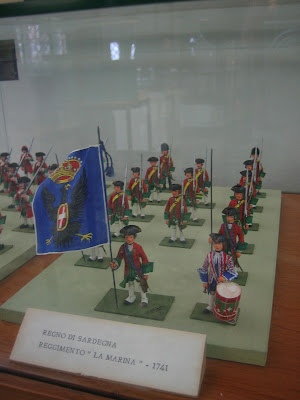It's not the first time I've been to Venice but it's a great city and it's worth visiting at least twice in a lifetime. Leaving the arrangements to my wife again proved best as she came up with a wonderful apartment, with outdoor space, in Dorsoduro very close to the Canale Della Giudecca.
The weather was variable. It ranged between 31 and 34 degrees Celsius, was breezier on some days than others, and there were even some clouds on the last morning. All in all, perfect weather for messing about in boats - and with no cars or buses, you tend to do a lot of that in Venice.
Apart from its unique architectural beauty Venice can boast a few bits of interest to the military enthusiast - and I spent a lot of time thinking what a great renaissance skirmish scenario a Venetian city battle would make, what with so many canals and bridges.
My first military port of call, pun intended, was the Arsenale and the maritime museum. The Arsenale is where the Venetians built their naval ships, at one time employing 2,000 people to build its galleasses and whatnot.
The Arsenale is still an active military base so you can't actually get into most of it but, the maritime museum has a few exhibits worth seeing, including a 'chariot' and several very nice scale models. There are also a few cabinets with proper lead soldiers in them.
Anyway, some pictures of what is there (caveat: most descriptions from memory).
A 'Chariot'.
For state of the art WW2 technology, I think this piece of kit is scarily basic.
This one was used against the British in Alexandria.
A 17th century galleass.
16th century swivel guns (recovered from the sea floor?) on reconstructed mountings
A Lepanto period galley. I'm definitely going to do this as a naval game at some point. Galleys (so wind isn't a major consideration) with cannon!
One of the most interesting models was this beauty. An 11th century Venetian galley.
The figures manning it were, at best guess, 40 mm.
I liked it so much I took three pictures of it.
The next lot of pictures I took for no other reasons than that they are of toy soldiers and they provide uniform guides for various horse and musket period marines. I will not be painting them, but someone might find these useful (sorry about the light, the sun was streaming in).
Finally there was this thing that took my fancy.
It's the flag ship of some Korean dude.
I believe that it might be called a 'Turtle Ship' and if my long term memory serves there is a full size replica of one somewhere (Korea?).
The model is belter (as models go) so I took three photos of it.
Next up, the Doge's Palace. The military angle is quite small here as it only comprises a small selection of the stuff in Venice's 'armoury'. Also, just so you know, not all of it is pictured here. Some of my shots were spoilt by the sunlight bouncing off the glass cabinets, including some containing some wonderful suits of armour (medieval and renaissance knight's full harness); there were many cabinets full of various weapons but, though nicely displayed, they were a bit samey. Also, I forgot to take my camera to the palace and had to use my wife's, with limited memory space.
Most of the collection dates from the late 15th through to the 17th century, so quite a bit had more than a passing interest. However, this visit to Venice was a family holiday so lengthy lingering over old steel was not an option.
Persian stuff. There is only one cabinet of this stuff and again the light has ruined the pictures of some stuff in it. Fortunately, the photo of the Persian 'mace' came out reasonably well.
BTW, all of the cutting weapons were described as daggers which, given their sword-like size, I thought a little adventurous.
I have no idea what this is (above the obvious). It was in a closed room and the photo was taken whilst leaning over the barrier at an ungainly angle with a security guard giving me the evil eye from ten paces.
Whatever it is (it looks eastern to me?), I bet it was pretty high velocity for its time!
So there we have it for my 'military bits of Venice'. Not exactly military fuelled but, for a family holiday, enough to keep me going - along with the book "1809. Thunder on the Danube" by J.H. Gill (thanks Gonsalvo, an excellent recommendation).

















































